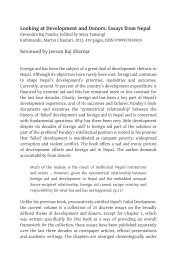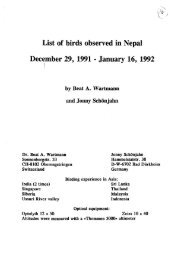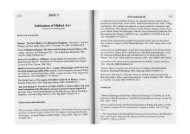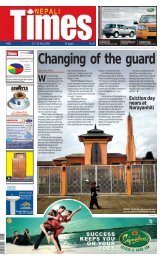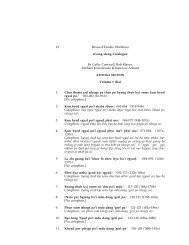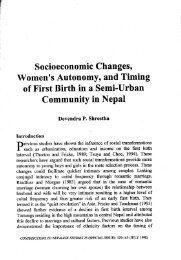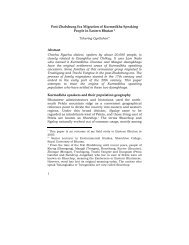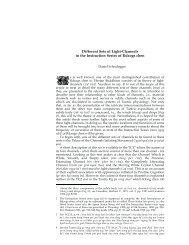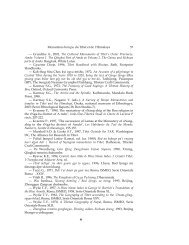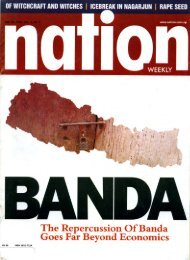Some Remarks on the Textual Transmission and Text of Bu ston
Some Remarks on the Textual Transmission and Text of Bu ston
Some Remarks on the Textual Transmission and Text of Bu ston
Create successful ePaper yourself
Turn your PDF publications into a flip-book with our unique Google optimized e-Paper software.
122<br />
Revue d’Etudes Tibétaines<br />
betan cultural area. <strong>Bu</strong>t we do know that by <strong>the</strong> beginning <strong>of</strong> <strong>the</strong><br />
ninth century <strong>the</strong>re were both imperial <strong>and</strong> m<strong>on</strong>astic [<strong>and</strong> perhaps<br />
even private] libraries in cultural Tibet, <strong>and</strong> <strong>the</strong>re is ample evidence<br />
that, in later times, wealthy noble families also owned private libraries<br />
that were kept separate, as <strong>the</strong>y were in <strong>the</strong> case <strong>of</strong> temples <strong>and</strong><br />
m<strong>on</strong>asteries, from <strong>the</strong> more secular instituti<strong>on</strong>al archives in which<br />
such documents as muniments, taxati<strong>on</strong> records, l<strong>and</strong> <strong>and</strong> labor c<strong>on</strong>tracts<br />
<strong>and</strong> <strong>the</strong> like were safeguarded. Often called dkar chag, many if<br />
not all m<strong>on</strong>asteries, estates, <strong>and</strong> palaces had <strong>the</strong>ir own inventories <strong>of</strong><br />
precious objects, from <strong>the</strong> statuary <strong>and</strong> sepulchres <strong>of</strong> <strong>the</strong>ir saints to<br />
<strong>the</strong>ir collecti<strong>on</strong>s <strong>of</strong> books <strong>and</strong> ritual bells, drums, paintings <strong>and</strong> o<strong>the</strong>r<br />
sacred objects. These existed ei<strong>the</strong>r as separate documents or in larger<br />
treatises that dealt with <strong>the</strong> history <strong>of</strong> <strong>the</strong> instituti<strong>on</strong>s in which<br />
<strong>the</strong>y were housed. Not many <strong>of</strong> <strong>the</strong>se have been published so far.<br />
<strong>Bu</strong>t a truly significant literary event would be <strong>the</strong> publicati<strong>on</strong> <strong>of</strong> <strong>the</strong><br />
dbu can manuscript <strong>of</strong> <strong>the</strong> m<strong>on</strong>umental dkar chag <strong>of</strong> <strong>the</strong> new m<strong>on</strong>astery<br />
<strong>of</strong> Chos 'khor sde chen that Karma bstan sky<strong>on</strong>g dbang po<br />
(1606-42), <strong>the</strong> last <strong>of</strong> <strong>the</strong> Gtsang pa Sde srid rulers, had built right<br />
above Bkra shis lhun po. 21 If memory serves, it was compiled <strong>and</strong><br />
written by 'Jam dbyangs Kun dga' bsod nams lhun grub (1571-1642)<br />
<strong>of</strong> <strong>the</strong> Sa skya pa school's Rtse gd<strong>on</strong>g Residence, <strong>the</strong> slightly incomplete<br />
<strong>and</strong> beautifully calligraphied manuscript originally c<strong>on</strong>sisted <strong>of</strong><br />
three hundred <strong>and</strong> ten folios. It is now inaccessibly stored away in<br />
ei<strong>the</strong>r <strong>the</strong> basement <strong>of</strong> <strong>the</strong> museum in Lhasa, or somewhere in 'Bras<br />
spungs m<strong>on</strong>astery. Several such inventories were also written for Sa<br />
skya <strong>and</strong> its temples, albeit <strong>on</strong> a less comprehensive scale, <strong>and</strong> a particularly<br />
significant <strong>on</strong>e is found in <strong>the</strong> eighth <strong>and</strong> last chapter <strong>of</strong> <strong>the</strong><br />
study <strong>of</strong> <strong>the</strong> m<strong>on</strong>astery <strong>and</strong> its ruling families Gtsang Byams pa Rdo<br />
rje rgyal mtshan (1423-98) completed in 1475. Worthy <strong>of</strong> a full analysis<br />
in its own right, we learn <strong>the</strong>re that <strong>the</strong> various temples already<br />
housed tens <strong>of</strong> thous<strong>and</strong>s <strong>of</strong> manuscripts <strong>and</strong> printed works, including<br />
manuscripts (phyag dpe) that had bel<strong>on</strong>ged to Ba ri Lo tsā ba Rin<br />
chen grags (1040-1111), Mal Lo tsā ba Blo gros grags (ca. 1100), 'Kh<strong>on</strong><br />
Dk<strong>on</strong> mchog rgyal po (1034-1102) — he was Sa skya's founder —,<br />
'Kh<strong>on</strong> Sgyi chu ba (ca. 1100), Gnang Kha'u ba Dar ma rgyal mtshan<br />
(ca. 1100) <strong>and</strong> <strong>the</strong> first four patriarchs, from Sa chen Kun dga' snying<br />
21<br />
evoluti<strong>on</strong> et devenir, ed. A. Chayet et al., Collectanea Himalayica 3 (Munich: Indus<br />
Verlag, 2010), 201 ff.<br />
C.P.N. catalog no. 004351. I first drew attenti<strong>on</strong> to this work in my "On <str<strong>on</strong>g>Some</str<strong>on</strong>g><br />
Early Tibetan Pramāṇavāda <strong>Text</strong>s <strong>of</strong> <strong>the</strong> China Nati<strong>on</strong>alities Library <strong>of</strong> <strong>the</strong> Cultural<br />
Palace <strong>of</strong> Nati<strong>on</strong>alities in Beijing," Journal <strong>of</strong> <strong>Bu</strong>ddhist <strong>and</strong> Tibetan Studies 1<br />
(1994), 24, n. 4. This short-lived journal has g<strong>on</strong>e <strong>the</strong> way <strong>of</strong> all flesh <strong>and</strong> is now<br />
defunct.






